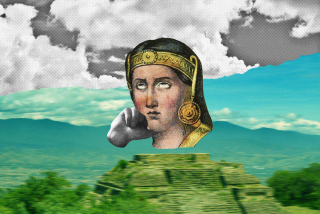Bones, Ahoy! But Whose?
- Share via
Who knew Chris Columbus was still working the world? No city more than L.A. comprehends how hard it is to stay in the news after your first big hit -- the critics, the skeptics, the tabloids and jealous studios. But still, according to a recent Times story by Carol Williams, after 512 years the alleged discoverer of the Americas is still cropping up in the news. Boy, who’s his publicist? More important, where’s the agent for Leif Eriksson, who’d been cooking cod in Newfoundland likely 60 years before the Nina lookout cried “Land, ho!” at the Bahamas, only he said it in Spanish?
Columbus’ people don’t have much to say nowadays, even on background. He’s dead, but in different places. The peripatetic post-life wanderings of Columbus’ bones and the transoceanic controversies surrounding them keep his name in the public eye. And isn’t publicity what life is mainly about?
Cristoforo Colombo, his stage name in Italian, did indeed wander the Caribbean and its islands, founding cities and resorts and -- all right, looking for gold. At his death in 1506, refrigeration not having taken hold, his remains were promptly buried first in Valladolid, Spain, then moved to a family mausoleum in Seville, and then to his beloved Santo Domingo.
Like many pieces of the Americas, the island changed hands, going to France in 1795. Beforehand, a Spanish delegation removed national treasures like old bones. But it seems Spanish custodians had already scrubbed names off the coffins to protect them from plunder. So who’s to know if the bones eventually returned to Spain were the real explorer’s or some street peddler’s? The Dominican bones, perhaps someone else’s, also went to Cuba a while. Then they found more bones in another Santo Domingo vault carrying Columbus’ name. So who is buried in Columbus’ tomb? A mystery for Columbo. Anyway, they’re DNA testing in Spain now and may do so in Santo Domingo.
No one doubts the lasting impact -- good and bad -- of Columbus’ discoveries and dispatches. Without the Nina, the Pinta and the Santa Maria, some of us wouldn’t be off-duty the second Monday of October, Italians would have to find another day to march -- though Spain financed Columbus -- and Disney wouldn’t have its own Caribbean island.
Tourism is, in fact, a driving force behind the fight over dem dry -- and peripatetic -- bones of Columbus. Millions seek to see them wherever. One thing is for sure: All this enduring publicity and controversy over a dead guy makes the living Miramax PR folks look like amateurs.
More to Read
Sign up for Essential California
The most important California stories and recommendations in your inbox every morning.
You may occasionally receive promotional content from the Los Angeles Times.













